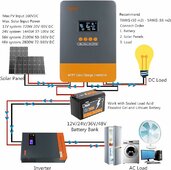Newbie and non expert at solar here but the fact you said overload in your original post would lead me to believe your startup current on the AC unit is too high for your system.
Anything with a compressor/motor that doesn't run off an inverter draws a massive load in comparison to working load.
I planned to power a fridge and chest freezer off my inverter the fridge was averaging 70w with a startup load of 170w due to its inverter, the chest freezer on the other hand averaged 100w with a startup load of +2kw as it had no inverter. First day I had constant overload warning so sadly the chest freezer got thrown from the party.
Personally (once Again no expert here) I would have think as your batteries start to drop to the lower end of soc the draw the AC unit demands at startup is so high it's putting the solar inverter to overload, not sure of pricing for your part of the world but here at least a better quality AC unit is cheaper than a decent battery.
Ps. When I say startup I don't actually mean when it's turned on, it occurs throughout the day as the compressor demands see graph below

Anything with a compressor/motor that doesn't run off an inverter draws a massive load in comparison to working load.
I planned to power a fridge and chest freezer off my inverter the fridge was averaging 70w with a startup load of 170w due to its inverter, the chest freezer on the other hand averaged 100w with a startup load of +2kw as it had no inverter. First day I had constant overload warning so sadly the chest freezer got thrown from the party.
Personally (once Again no expert here) I would have think as your batteries start to drop to the lower end of soc the draw the AC unit demands at startup is so high it's putting the solar inverter to overload, not sure of pricing for your part of the world but here at least a better quality AC unit is cheaper than a decent battery.
Ps. When I say startup I don't actually mean when it's turned on, it occurs throughout the day as the compressor demands see graph below





